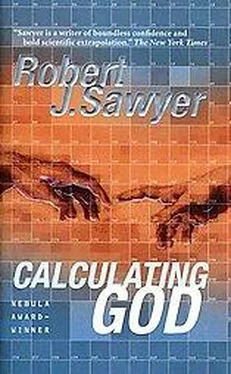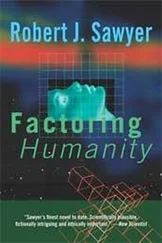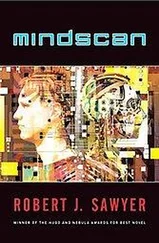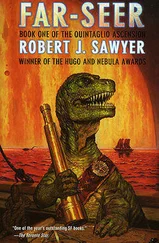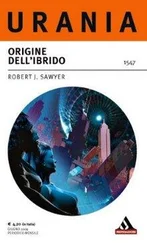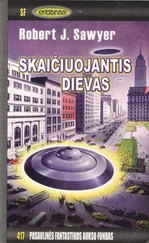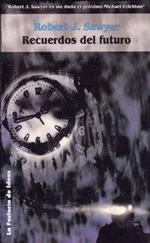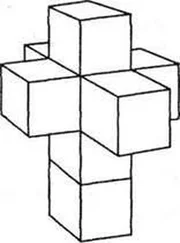Robert Sawyer - Calculating God
Здесь есть возможность читать онлайн «Robert Sawyer - Calculating God» весь текст электронной книги совершенно бесплатно (целиком полную версию без сокращений). В некоторых случаях можно слушать аудио, скачать через торрент в формате fb2 и присутствует краткое содержание. Город: New York, Год выпуска: 2000, Издательство: Tor Books, Жанр: Фантастика и фэнтези, на английском языке. Описание произведения, (предисловие) а так же отзывы посетителей доступны на портале библиотеки ЛибКат.
- Название:Calculating God
- Автор:
- Издательство:Tor Books
- Жанр:
- Год:2000
- Город:New York
- ISBN:нет данных
- Рейтинг книги:5 / 5. Голосов: 1
-
Избранное:Добавить в избранное
- Отзывы:
-
Ваша оценка:
- 100
- 1
- 2
- 3
- 4
- 5
Calculating God: краткое содержание, описание и аннотация
Предлагаем к чтению аннотацию, описание, краткое содержание или предисловие (зависит от того, что написал сам автор книги «Calculating God»). Если вы не нашли необходимую информацию о книге — напишите в комментариях, мы постараемся отыскать её.
Calculating God — читать онлайн бесплатно полную книгу (весь текст) целиком
Ниже представлен текст книги, разбитый по страницам. Система сохранения места последней прочитанной страницы, позволяет с удобством читать онлайн бесплатно книгу «Calculating God», без необходимости каждый раз заново искать на чём Вы остановились. Поставьте закладку, и сможете в любой момент перейти на страницу, на которой закончили чтение.
Интервал:
Закладка:
“Ah,” said Hollus.
“A smoking gun is incontrovertible evidence. And that’s what I want: indisputable proof.”
“There is no indisputable proof for the big bang,” said Hollus. “And there is none for evolution. And yet you accept those. Why hold the question of whether there is a creator to a higher standard?”
I didn’t have a good answer for that. “All I know,” I said, “is that it will take overwhelming evidence to convince me.”
“I believe you have already been given overwhelming evidence,” said Hollus.
I touched my head, feeling the smoothness where my hair used to be.
Hollus was right: we do accept evolution without absolute proof. Sure, it seems clear that dogs are descended from wolves. Our ancestors apparently domesticated them, breeding out the fierceness, breeding in companionability, eventually turning the Ice Age Canis lupus pallipes into Canis familiaris, the modern pooch with its 300 sundry breeds.
Dogs and wolves can’t jointly reproduce anymore, or, at least, if they do, the offspring are sterile: canines and lupines are different species. If that’s the way it really happened — if human breeding turned Akela into Rover, creating a new species — then one of the basic tenets of evolution has been demonstrated: new species can be created from old ones.
But we can’t prove the evolution of the dog. And in all the thousands of years we have been breeding dogs since, producing all those myriad kinds, we have not managed to create a new canine species: a Chihuahua can still mate with a Great Dane, and a pit bull can hump a poodle — and both unions can bring forth fertile young. No matter how much we try to emphasize their differences, they are still Canis familiaris. And we’ve never created a new species of cat or rat or elephant, of corn or coconut or cactus. That natural selection can produce changes within a type is disputed by no one, not even the staunchest creationist. But that it can transform one species into another — that, in fact, has never been observed.
In the vertebrate-paleontology gallery at the ROM, we’ve got a long diorama filled with horse skeletons, starting with Hyracotherium from the Eocene, then Mesohippus from the Oligocene, Merychippus and Pliohippus from the Pliocene, then Equus shoshonensis from the Pleistocene, and finally today’s Equus caballus, represented by a modern quarter horse and a Shetland pony.
It sure as hell looks like evolution is happening: the number of toes reduce from Hyracotherium’s four on the front feet and three on the rear until there’s only one, in the form of a hoof; the teeth grow longer and longer, an apparent adaptation for eating tough grasses; the animals (excepting the pony) get progressively larger. I pass that display constantly; it’s part of the background of my life. Rarely do I give it any thought, although often enough I’ve interpreted it when conducting VIP tours of the gallery.
One species giving rise to the next in an endless pageant of mutations, of adaptations to ever-changing conditions.
I accept that readily.
I accept that because Darwin’s theory makes sense.
So why don’t I also accept Hollus’s theory?
Extraordinary claims require extraordinary proof.That had been Carl Sagan’s mantra when confronted by UFO nuts.
Well, guess what, Carl? The aliens are here — in Toronto, in L.A., in Burundi, in Pakistan, in China. The proof is inescapable. They are here.
And what about Hollus’s God? What about the proof for an intelligent designer? The Forhilnors and Wreeds had more concrete evidence, it seemed, for that than I had for evolution, the intellectual framework upon which I’d built my life, my career.
But . . . but . . .
Extraordinary claims. Surely they must be held to a higher standard. Surely the proof should be monumental, irrefutable.
Of course it should be.
Of course.
10
Susan had come with me last October when I’d gone down to St. Michael’s Hospital to meet the oncologist, Katarina Kohl.
It was a terrifying experience, for both of us.
First, Dr. Kohl conducted a bronchoscopic examination. She passed a tube ending in a camera through my mouth into the airway subdivisions of each lung, in hopes of getting at the tumor and collecting a sample. But the tumor was unreachable. And so she performed a needle biopsy, pushing a fine needle through my chest wall directly into the tumor, guided by x rays. Although there had been no doubt, based on the cells I’d coughed up with my phlegm, that I had cancer, this specimen would nonetheless confirm the diagnosis.
Still, if the tumor was isolated, and we knew where it was, it could be surgically removed. But before opening my chest to do so, another test was required: a mediastinoscopy. Dr. Kohl made a short incision just above my breast bone, cutting down to the trachea. She then passed a camera tube through the incision and pushed it down along the outside of my windpipe to inspect the lymph nodes near each lung. More material was removed for inspection.
And, at last, she told Susan and me what she’d found.
We were devastated by the news. I couldn’t catch my breath, and even though I was sitting down when Kohl showed us the test results, I thought I might lose my balance. The cancer had spread to my lymph nodes; surgery would be pointless.
Kohl gave Susan and me a few moments to compose ourselves. The oncologist had seen it a hundred times, a thousand times, living corpses looking at her, horror on their faces, fear in their eyes, wanting her to say she was just kidding, it was all a mistake, the equipment had malfunctioned, there was still hope.
But she said none of that.
There’d been a cancellation for two hours hence; a CAT scan would be possible that very day.
I didn’t ask why whoever had had the appointment had failed to keep it. Perhaps he or she had died in the interim. The entire cancer ward was filled with ghosts. Susan and I waited, silently. She tried to read some of the outdated magazines; I kept staring into space, my mind racing, eddying.
I knew about CAT scans — computerized axial tomography. I’d seen lots of them done. From time to time, one or another of Toronto’s hospitals will let us scan an interesting fossil when the equipment isn’t being otherwise used. It’s an effective way to examine specimens that are too fragile to remove from the matrix they’re encased in; it’s also a great way to see the interior structures. We’ve done some wonderful work on Lambeosaurus skulls and Eucentrosaurus eggs. I knew all about the procedure — but I’d never had it done to myself before. My hands were sweating. I kept feeling like I was going to throw up, even though none of the tests should have made me nauseous. I was frightened — more frightened than I’d ever been in my life. The only time I’d been even close to this nervous was while Susan and I were waiting for word about whether we were going to get to adopt Ricky. We had sat by the phone, and every time it rang our hearts jumped. But we’d been waiting for good news, then . . .
A CAT scan is painless, and a little radiation could hardly do me any harm now. I lay down on the white pallet, and the technician slid my body into the scanning tunnel, producing images that showed the extent of my lung cancer.
The substantial extent . . .
I’d always been a student, a learner — and so had Susan, for that matter. But the facts and figures came in a dizzying flurry that day, disjointed, complex, too much to absorb, too much to believe. Kohl was detached — she’d given these lectures a thousand times before, a tenured prof, bored, tired.
Читать дальшеИнтервал:
Закладка:
Похожие книги на «Calculating God»
Представляем Вашему вниманию похожие книги на «Calculating God» списком для выбора. Мы отобрали схожую по названию и смыслу литературу в надежде предоставить читателям больше вариантов отыскать новые, интересные, ещё непрочитанные произведения.
Обсуждение, отзывы о книге «Calculating God» и просто собственные мнения читателей. Оставьте ваши комментарии, напишите, что Вы думаете о произведении, его смысле или главных героях. Укажите что конкретно понравилось, а что нет, и почему Вы так считаете.
